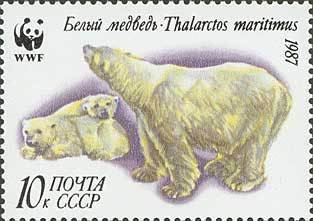Stamp: Polar Bear (Ursus maritimus) (Soviet Union, USSR 1987)
Polar Bear (Ursus maritimus) (Soviet Union, USSR 1987)
25 March (Soviet Union, USSR ) within release WWF goes into circulation Stamp Polar Bear (Ursus maritimus) face value 10 Russian kopek
| Stamp Polar Bear (Ursus maritimus) in catalogues | |
|---|---|
| Michel: | Mi:SU 5695 |
| Yvert et Tellier: | Yt:RU 5392 |
Stamp is horizontal format.
Also in the issue WWF:
- Mini Sheet - Polar Bear (Ursus maritimus) face value 10;
- Stamp - Polar Bear (Ursus maritimus) face value 20;
- Mini Sheet - Polar Bear (Ursus maritimus) face value 20;
- Mini Sheet - Polar Bear (Ursus maritimus) face value 35;
- Stamp - Polar Bear (Ursus maritimus) face value 5;
- Stamp - Polar Bear (Ursus maritimus) face value 10;
Stamp Polar Bear (Ursus maritimus) it reflects the thematic directions:
Bears are carnivoran mammals of the family Ursidae (/ˈɜːrsɪdiː, -daɪ/). They are classified as caniforms, or doglike carnivorans. Although only eight species of bears are extant, they are widespread, appearing in a wide variety of habitats throughout most of the Northern Hemisphere and partially in the Southern Hemisphere. Bears are found on the continents of North America, South America, and Eurasia. Common characteristics of modern bears include large bodies with stocky legs, long snouts, small rounded ears, shaggy hair, plantigrade paws with five nonretractile claws, and short tails.
The polar bear (Ursus maritimus) is a large bear native to the Arctic and nearby areas. It is closely related to the brown bear, and the two species can interbreed. The polar bear is the largest extant species of bear and land carnivore, with adult males weighing 300–800 kg (660–1,760 lb). The species is sexually dimorphic, as adult females are much smaller. The polar bear is white- or yellowish-furred with black skin and a thick layer of fat. It is more slender than the brown bear, with a narrower skull, longer neck and lower shoulder hump. Its teeth are sharper and more adapted to cutting meat. The paws are large and allow the bear to walk on ice and paddle in the water.
Animals are multicellular, eukaryotic organisms of the kingdom Animalia (also called Metazoa). All animals are motile, meaning they can move spontaneously and independently, at some point in their lives. Their body plan eventually becomes fixed as they develop, although some undergo a process of metamorphosis later on in their lives. All animals are heterotrophs: they must ingest other organisms or their products for sustenance.


